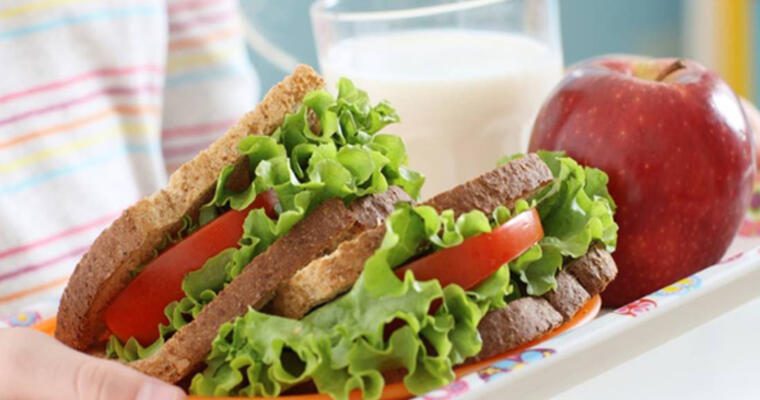The Healthy, Hunger-Free Kids Act of 2010 took responsibility for the overhaul of the National School Lunch Program (NSLP) and School Breakfast Program (SBP), which required the USDA to establish school nutrition standards for all foods. As a result, the Smart Snacks in Schools standards were created, drawing on recommendations from the Institute of Medicine, as well as existing voluntary standards already implemented by thousands of schools across the country.
These Competitive Food standards will go into effect for the 2014-15 school year, and apply to all foods sold on school campuses between the midnight before school, to 30 minutes after the end of the school day. Included in this rule are all foods sold in vending machines, at school stores, and a la carte in the lunchroom. Foods sold on weekends or at off-campus fundraising events are not subject to these guidelines.
Any food sold as a “Smart Snack” must meet one of the following nutritional guidelines:
- Be a whole grain rich product
- Have a fruit, vegetable, dairy product, or protein as the first ingredient
- Be a combination food containing at least ¼ cup of fruits or vegetables
- Contain 10% of the daily value of calcium, potassium, vitamin D, or dietary fiber
The following nutrition standards must be met for all “Smart Snacks”:
Fat Limits
- Total Fat: </= 35% of calories
- Saturated Fat: < 10% of calories
- Trans Fat: Zero grams
Exemptions to this rule include: reduced-fat cheese, nuts, seeds and nut/seed butters, and seafood with no added fat.
Sugar Limits
- </= 35% of weight from total sugars in foods
Exemptions to the sugar limit rule include dried whole fruits or vegetables.
Sodium Limits
- Snack Items: </= 230 mg/portion as packaged
- Entrée Items: </= 480 mg/portion as packaged, unless part of the SBP/NSLP
Calorie Limits
- Snack Items: </= 200 calories
- Entrée Items: </= 350 calories, unless part of the NSLP
Exemptions from the Nutrition Standards for Foods: Any entrée offered as part of the lunch or breakfast program may be sold a la carte on the day of, or the day after service. This exemption does not apply to side dishes; all side dishes must meet school nutrition standards.
Campus Guidelines for Beverages
Beverages have their own set of standard requirements, and while they do not have to meet the listed food standards, they must adhere to specific serving size and calorie requirements.
For a la carte beverages, all schools may sell plain water, plain low-fat milk, plain or flavored fat-free milk, and 100 percent fruit or vegetable juice. There are, however, portion size restrictions on milk and juice, depending on grade level.
For elementary schools, up to eight ounce portions of milk and juice may be served, while middle and high schools may serve up to 12 ounces. Water is the only drink that does not have to adhere to these size restrictions.
High schools are allowed to serve additional beverages under the Competitive Food rule, as long as these beverage portions are 20 ounces or less. These drinks include calorie-free flavored or unflavored water (carbonated or not), and any other calorie-free beverages defined as < 5 calories per 8 ounce serving, or </= 10 calories per 20 ounce serving. Additionally, lower calorie beverages may be served in up to 12 ounce portion sizes.
These lower calorie beverages are defined as having </= 40 calories per 8 ounce serving, or </= 60 calories in a 12 ounce serving.
Caffeine-Free Drinks in Schools
Elementary and middle school beverages must be caffeine-free, with the exception of trace amounts of naturally occurring caffeine substances. For high schools, caffeine is allowed in both foods and beverages.
Smart Snack Nutrition Standards
To help determine which snacks meet these standards, the Alliance for a Healthier Generation has developed a Smart Snacks calculator which can be used to quickly and easily determine if a food or beverage product meets the Smart Snacks requirements.
This USDA endorsed tool is available on the Alliance for a Healthier Generation website, and has been identified as the standard for assessing all snack foods in your school.
Please remember that some states have more strict rules, and may also offer exemptions for some infrequent fundraising activities. To see which Competitive Food complaint items Gordon Food Service supplies, customers can visit GFS Experience.
What Does Your School’s Campus Need to Meet the Competitive Food Standards?
How can we help? Gordon Food Service provides school foodservice directors the following tools to help your school meet the Competitive Food and Smart Snacks regulations:
- Smart Snacks Product lists on GFS Experience > Resources > Great for Schools > Competitive Foods
- Nutrition Resource Center (NRC) – a team of knowledgeable Registered Dietitians who can answer your Smart Snacks questions and assist you in identifying compliant products. To contact the NRC, email nrc@gfs.com or call 1.800.968.4426











